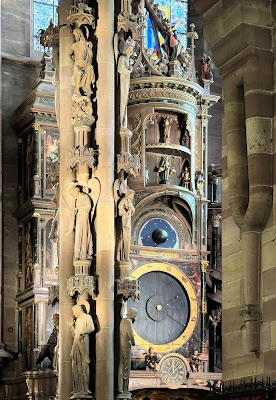Who hasn't seen the photo of the Strasburg Cathedral with its only one steeple?
A week ago, Red Baron took part in an excursion to Strasbourg organized by the Freiburg Münsterbauverein. The plan was to visit the minster repair workshop, see a demonstration of the famous astronomical clock, and take a detailed tour of the Strasbourg Cathedral.
After a march from the bus parking lot, we arrived first in front of the cathedral and waited for the rest of the group to catch up.
At the cathedral repair workshop entrance, we were greeted by St. Benedict of Nursia, pointing with his finger to the rule of “his“ order (Regula S. Benedict), and Blessed Eberhardt of Einsiedeln.
Eberhardt, taking the example of the monastery of St. Gall, founded the Benedictine monastery of Einsiedeln around 934 with Benno of Metz and the hermits living there. Around 950, Eberhardt was the provost of the Strasbourg cathedral chapter and his statue bears a copy of the original Romanesque cathedral church.
Before our group visited the workshop, we learned about the origin of the
present cathedral.
Like in Freiburg, the new construction started at the transept and advanced in the direction of the steeples, keeping the old building as much as possible operational for holding mass. The new cathedral was built on the old foundations.

|
| ©Wikipedia/PogoEngel |

|
| Another masterpiece, this time in stone, ready to be installed |
In Stasbourg's cathedral workshop, there is a clear distinction between
sculptors and stonemasons.

|
| A sculptor is reproducing an ornamental piece with the help of a plaster cast |

|
| The breathtaking work of a stonemason |
We could have stayed on, but we wanted to attend the presentation of the cathedral's famous astronomical clock in the south part of the transept.

|
| We, too, went on a visit out of the ordinary. |

|
|
The flat wall you are looking at is the oldest part identified so far.
It dates back to 1050. |

|
| Richly ornamented column capitals |

|
| On the left is the column with sculptures of the last judgment |
On our way to the north part of the transept, Red Baron looked right...

|
|
What looks like a mosaic on the walls of the choir are paintings
realized during the "German years" from 1871 to 1919. |
... and turned his eyes left on to the famous rosette window.
In the north part of the transept, I took the following photo:

|
| Texts of a German-speaking Straßburg in the late 16th century |
The Reformation hit a fertile ground in Alsace early on. Already in
1524, the city council assigned the Minster to the followers of the
Lutheran faith. Thus, in 1539, the first Christmas tree in the world is
said to have been displayed in Strasbourg‘s cathedral,
or was it earlier?

|
| Festive lighting on the occasion of the return of the cathedral to the Catholic Church |
Eighty-nine years later, the people of Freiburg do not let themselves be left behind and illuminated their Minster Church on the occasion of Marie-Antoinette's visit on her way to Paris. To the abbot of St. Märgen, the illuminated steeple appeared like a fallender feyriger Zukerhut (falling fiery sugar loaf).
Back to the visit. The pulpit in the Strasbourg Cathedral is an exceptional work of art. Red Baron admits that the explanations of our guide met a full
brain.
Therefore, like many visitors, I only took the doggy's head, greasy and dirty from all the touching.
Before we left the cathedral, our eyes fell on The Stone of Europe,
a decorative pinnacle made up of 18 elements in different materials by
European cathedral workshops. Since 2020, the traditional skills of these
workshops have been listed as intangible Cultural Heritage by UNESCO. Admire the various materials fitting together. The Strasbourg and Freiburg
workshops are represented.
This memorable excursion was well organized. Thank you.
NB: Click on the pictures to enlarge
*













No comments:
Post a Comment